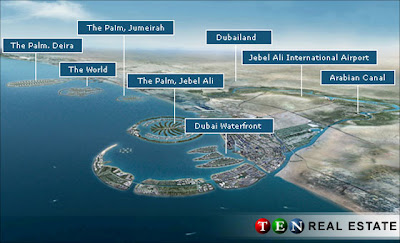The Dubai Waterfront will extend Dubai's coastline by 820 kilometers, twelve times the length of its current coastline. It will consist of 440 square kilometers of water and land developments, an area seven times the size of Manhattan, New York in the United States. It is expected to house 400,000 people.
Located near to the new Dubai World Central International Airport, and with direct access to Sheikh Zayed Road, Jebel Ali Freezone and Abu Dhabi, the city will be fully accessible on a local and international scale.
The project will feature hundreds of waterfront developments and planned communities. It will consist of 10 key areas including Madinat Al Arab , which is expected to become the new downtown and central business district of Dubai. Madinat Al Arab has been carefully crafted and developed by an international consortium of highly regarded architects, planners and urban developers. It will be anchored by Al Burj, which when completed is expected to be 700 meters to one kilometer in height, making it one of the world's tallest buildings. Madinat Al Arab will feature resorts, retail, commercial spaces, public spaces, a broad mix of residencies and an integrated transport system including light rail and a sophisticated road network.
Related Topics:
Dubai Sightseeing
Dubai Visa
Dubai Airport
Things to do in Dubai
Burj Dubai tower


No comments:
Post a Comment
Contoh Makalah Jurnal Skripsi Tesis
PDF Download PDF Search Engine
Art Gallery Artist - Contemporary Abstract Paintings and Graphics
History of Art, Artists & Art Movements
Top 30 Hot Music Downloads
Top Digital Songs
Christian Residential Drug Treatment
Donate Your Car San Francisco
Firm Law Mesothelioma Texas
Ms Exchange Server Hosting
Villa di Piazzano Cortona Italy Hotel
Windows Download Software
Windows Download Center
plastic surgery before and after korean
Fashion N style
Aliving Room Furniture
The Hotels Las Vegas
Acamping Sites
About Hilton Hotels
Note: Only a member of this blog may post a comment.